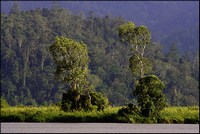National Parks in Sulawesi
 Across Indonesia there are several national parks that are not only beautiful and surreal to a certain aspect some are also a great attraction for divers and lovers of the oceans. The parks themselves are a hive of activity with an immense array of flora and fauna unlike any other in the world on display for the enthusiast. The island of Sulawesi is a nature-lovers delight in every facet. Its wildlife is found nowhere else in the world and it’s no wonder Alfred Wallace declared this island so fascinating. The combination of lush tropical rainforests caressing the golden sands of its beaches and the high mountainous areas make the national parks of Sulawesi a definite part of your visit there. In Indonesian national parks are threatened by the economics of the country. The biggest threat to parks is the encroachment of mankind in the pursuit of land to grow palm oil or to reap the forests of their wood. Fortunately there are conservation ‘watchdog’ groups like WAHLI and WWF to maintain the status quo.
Across Indonesia there are several national parks that are not only beautiful and surreal to a certain aspect some are also a great attraction for divers and lovers of the oceans. The parks themselves are a hive of activity with an immense array of flora and fauna unlike any other in the world on display for the enthusiast. The island of Sulawesi is a nature-lovers delight in every facet. Its wildlife is found nowhere else in the world and it’s no wonder Alfred Wallace declared this island so fascinating. The combination of lush tropical rainforests caressing the golden sands of its beaches and the high mountainous areas make the national parks of Sulawesi a definite part of your visit there. In Indonesian national parks are threatened by the economics of the country. The biggest threat to parks is the encroachment of mankind in the pursuit of land to grow palm oil or to reap the forests of their wood. Fortunately there are conservation ‘watchdog’ groups like WAHLI and WWF to maintain the status quo.
Here area few of the most interesting and larger national parks in Sulawesi:
Lore Lindu National Park: Basically a forest preserve in Central Sulawesi, it covers an area of 2,290 km² covering both lowland and montane forests. The park contains stone megaliths dating from ca. 1300. The national park is an official UNESCO Biosphere Reserve. The fauna to be found here include 227 bird species and one of the most popular being the Red-Knobbed Hornbill. There are 77 bird species endemic to this island. You will also find Giant Civets here.
Togean National Park: This island chain is an ecological wonder located in the regency of Tojo Una-Una in Central Sulawesi. In area it is a 411,373-hectare area marine tourism park. In October 2004, another362,605 ha were added to the park to create the actual Togean National Park. The island chain is noted for its rich marine life and has some of the best snorkelling and diving in Sulawesi.
Bunaken National Park: The highest elevation in this park is a volcanic tuft and quite stunning. It has a significant amount of uplifted fossil coral and at the west and central parts of the island there is a flat plateau about 5Om above sea level. Nain Island is a dome-shaped island whereas Mantehage Island is relatively flat and seems to be sinking into the sea. The island has extensive mangrove forest flats, partially separated by saltwater channels. Siladen is a low-lying coral sand island with no significant topography. Arakan-Wawontulap and Molas-Wori on the mainland of North Sulawesi are relatively flat areas at the base of volcanic hills. Bunaken National Park covers an area of 89,095 hectares. The marine national park area is home to thousands of different species of fish, coral, endangered marine mammals and reptiles, birds, molluscs and mangrove species. The uniqueness of Bunaken has made this destination one of the prime diving spots in the whole archipelago.
Bogani Nani Wartabone National Park: This park ha s an area of 2,871.15 km² and located on the Minahassa Peninsula. It was formerly known as Dumoga Bone National Park. The park has been identified by Wildlife Conservation Society as the single most important site for the conservation of Sulawesi wildlife and is home to a large number of species endemic to Sulawesi. The species observed in the park include among others the endangered Anoa and Cinnabar Hawk Owl.
Wakatobi Marine Park: Once known as Kepulauan Tukangbesi, it is located in the extreme south-east of Sulawesi and comprises an area of 1,390,000 ha. The Wakatobi archipelago consists of four major islands (Wangiwangi, Kalidupa, Tomia, Binongka), several little islands and the surrounding coral reefs. Pulau Moromaho is important for seabirds.
Taka Bone Rate Marine Park: Home to the third biggest atoll in the world after Kwajifein in the Marshall Isles and Suvadiva in the Moldiva Isles, the total area of the atoll is about 220,000 hectares with coral reefs spreading over 500km2. The national park includes an area of 530,765 ha. Taka Bonerate is a Bugis’s name that somewhat has a meaning ‘Coral Piled Up on Sand’. There are 15 islands in taka Bonerate National Park where visitors can enjoy diving, snorkelling and marine tours.
Rawa Aopa Watumohai National Park: Located in South East Sulawesi, it was declared a national park in 1989 and has an area of 1,050 km². The area ranges from sea level to the altitude of 981 m and has a variety of vegetation including sub-montane rain forests, mangrove forests, coastal forests, savanna and freshwater swamp forests. It is home to Babirusa, both species of endangered Anoa – essentially miniature Water Buffalos – and 155 bird species, of which 37 are endemic to Sulawesi, and 323 species of plants.